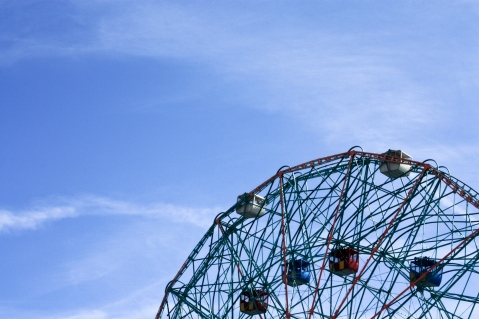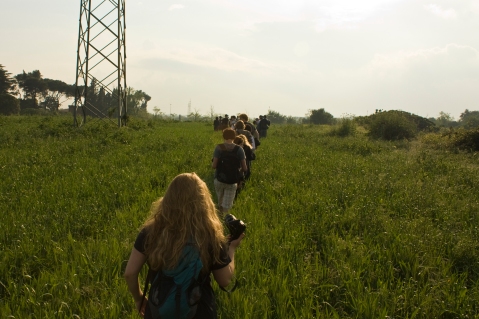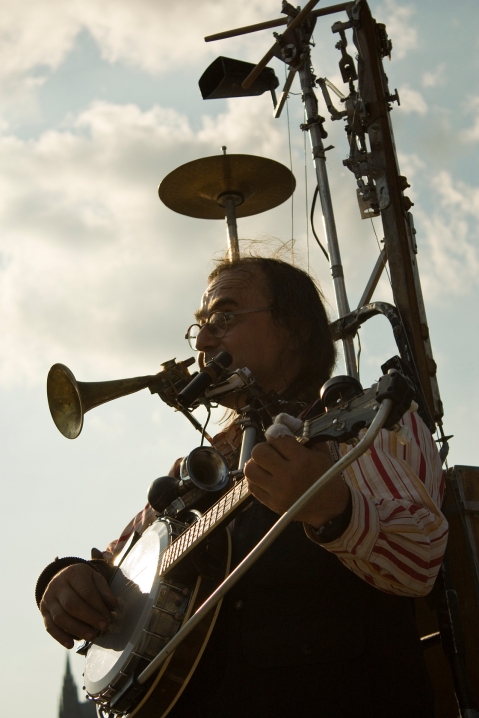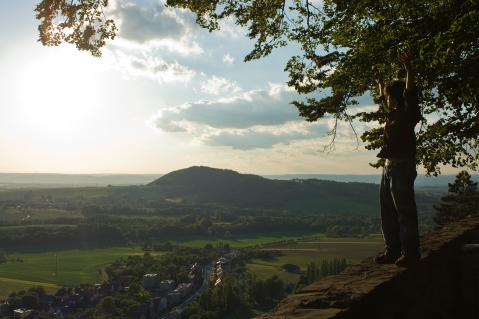CAMS Roadtrip ’09 – Five Year Lookback
Five years ago this spring, I was tiptoeing onto what turned out to be the trailhead of a path I’m still on as a traveler and photographer. At the risk of waxing nostalgic: it was clear to me immediately following the 10-week “roadtrip” that the program would have a profound impact on the direction of my studies and interests. With five years of hindsight, I’ve realized that I simply would not be where I am today without this formative study-abroad experience.
In reflecting on this milestone, I looked back on some of the 10,000 photos I captured during time I spent lost and found in New York City, Rome, around Austria, Prague and the Czech Republic. Firstly, I will note that 10,000 is more than twice the number of images I took during a similar time frame for Walking Walls. Secondly, although most of these photos are terrible, the improvements between 0 and 10,000 were impressively gigantic, which came as a nice surprise. I also “rediscovered” a number of previously unedited images that I really liked. It was fun to unearth these from the depths of my hard drive, but the real excitement came from reflecting on the moment of capture, appreciating the forces that brought me to that point, and what small wisdom has followed me since.
I’m hoping my fellow roadtrippers might share some of their hindsights and hard drive discoveries over the next two months as well. Here’s a small sampling of mine:
Sunrise Shoot in Allston – New Project
I started my day with a bleary-eyed trip to the cafe below my apartment and hopped on a crowded bus before the sky was light. Sunrise found me on the Cambridge Street bridge overlooking the Mass Pike and a sprawling railyard. The sun kissed downtown buildings when it finally appeared on the horizon.
I’m shooting for a new project and it’s really exciting! More to come.
Guest Blog: Camera Records In Time
I recently got involved with a photography collective here in Boston called Camera Records In Time (C.R.I.T). I showed an edit of Walking Walls at a meeting in May and followed up with a blog post, which is currently headlining their site. It was awesome to get input on the project from fellow photographers and I’m anticipating that similar group critiques will continue to be an important aspect of my continuing work!
Things Gathered
This is one of my only pictures from January 17, 2012. I had just boarded a bus from the side of a small highway near Ben Gurion Airport in Tel Aviv, fairly sure that it was bound for Jerusalem. I was fascinated by the accouterments that the bus driver had affixed to his ceiling. There was a Star of David that looked like it had been fashioned out of Popsicle sticks, a few photos, air fresheners, and most mysteriously, a row of red things that resembled small shovels. I was struck by how the collection was vividly personal but on display, strange in its look and arrangement but familiar in sentiment.
90 Days of Walking Walls
Exactly one year ago, I was laying in a warm bed in a nondescript flat in Vienna. My girlfriend’s arm was draped easily over my chest, her breathing steady while outside, snow fell thick and fast for the first time all year. It was almost time to get up, but I hadn’t slept to begin with; rest would not come. My mind had been projecting a relentless loop of blurry horrors on my path ahead which prevented me from closing my eyes for too long. This was the first time I fell prey to my imagination by night, but it would not be the last. I said goodbye to her at the bus stop, night heavy around us despite the orange haze rising from the blanket of snow.
Exactly one year ago, I took my first physical steps of Walking Walls. Those steps took me from the comfort of Vienna to an airport terminal in Berlin where I observed a pair of Orthodox Jews with a strange intensity; to Tel Aviv where I refused to let the customs agent stamp my passport; to the streets of Jerusalem, where I somehow found my way to my friend’s flat in Nachlaot, the world buzzing around me and wet stones slippery underfoot.
Tonight, my girlfriend will come to bed, drape her arm across me, and we will go to sleep in our American apartment where it is very easy to rest and I rarely awake with last year’s half-remembered visions a scream on my lips.
Last year, I was beginning a long and lonely journey that was often terrifying but ultimately rewarding.
I have not yet found its end.
As I continue to reflect on my time in Israel, Palestine, Cyprus, and Northern Ireland, I have been seeking new conversations, lenses, and methods for examining my experiences. I’ve tried to quantify what it was to wake up softly on a chilly morning in Jerusalem, to feel again the peculiar mixture of awe, intoxication, and trepidation when I first saw strips of light marking the Buffer Zone from a university campus in North Cyprus, or to understand with my head a certain ache of my legs and heart after walking miles across Belfast to visit strange neighborhoods.
I have few illusions that these sketches of memory will ever be more than pieces in my quiet and private portrait of self-confidence. Though really, that is quite enough. But, anniversaries are a time to remember, reexamine, and contextualize events of the past. They are dates that demand attention, for better or for worse. And so, to mark the 1-year anniversary of Walking Walls, I have posed the following challenge for myself:
1. Every day, post a photograph that was taken a year ago and has not been posted previously on this blog (if one exists).
2. Craft a brief reflection on the photograph, the day as a whole, or a moment of the day, ideally reflecting an idea that that has not been discussed extensively on this blog.
It is my hope that this process will allow me to think more deeply about my experience of Walking Walls than I have had time to do since getting home. The length of the challenge will mirror the length of the trip, thus matching my new reflections to the speed of the previous year’s progression of travel and thinking. Furthermore, I will be able to connect last year to the present by reliving my trip in some small way for the next 90 days, considering what forces I encountered last year that shape my thinking now. And finally, I hope to give life to the small memories and strange photographs that I know exist, but have been ignored because they had little to do with Walking Walls and everything to do with life on the road, strange experiences, and an eye-opening journey.

For a start, here’s the only picture I took on January 16th, 2012, using my phone. This was supposed to be my directions from the Jerusalem bus station to the place I was staying in Nachlaot. Of course, I didn’t account for the fact that I didn’t understand any Hebrew characters, rendering the street names on this map useless.
But what was I expecting? How could I use this map when it was from a different world?–the world I knew before I woke from a foggy fear, got on a bus and then a plane, slammed my feet on the ground in Jerusalem, and kept walking.
Borders in America
This summer, I biked roughly 3,000 miles, coast to coast, across the United States of America. Well, eight of them, to be exact, which meant crossing seven state lines. Given the nature of this trip, some of these crossings were hasty, or occurred at awkward times. New Mexico in the exhausted evening hours while we raced the sun to the horizon. Arizona on a day where 4 members of our group threw up continually from a mysterious illness. Alabama, for me, in a car while I got a ride with an injured team member. California in the dark on our longest day of riding.
This trip, shockingly, was not about borders, differences between states, or anything remotely related. However, I couldn’t keep my mind entirely off the subject and wanted to share some observations from the road, state-to-state.
1. Georgia to Alabama:
Alabama is hillier, the country begins to roll toward the mighty Mississippi. Few cultural differences noted.
2. Alabama to Mississippi:
Mississippi does not believe in shoulders on the road. There are none in the entire state. More dogs chase us here.
3. Mississippi to Arkansas:
Undeniably the most physically obvious, spectacular crossing we have on the entire trip-a real treat to bike over an awesome bridge and survey the wide and slow Mississippi River. Suddenly, the number of African-Americans plummets.
4. Arkansas to Oklahoma:
Our first glimpse of wide open spaces. People are not as warm here, but still amiable. We see oil rigs for the first time. Walmarts begin to diminish in frequency.
5. Oklahoma to New Mexico:
Suddenly, everything is different, and not just because we are finally, miraculously out of the panhandle. Everyone has jeeps or sports cars, not pickups, and they have bikes, coolers, or camping gear strapped to their vehicles. They honk enthusiastically at us. Mountains spring up within the day’s ride to the state border and we are undeniably in the west.
6. New Mexico to Arizona:
A border, but not a border. We are still on the Navajo Reservation, and this seems to trump the state border. There are more foreign tourists as we approach the Grand Canyon, and hostile RV drivers.
7. Arizona to California:
The air crackles with anticipation because we are so close to the Pacific Ocean. Everything in California is cool because it is California. We see many borders within this state: in four days, the desert gives way to the rural, until the mountains, which make room for Los Angeles, inevitably replaced by the ocean. We made it.
While I’ve been globetrotting in conflict zones and other international borders, I have to admit that I completely overlooked borders between American states (not to mention the complex and invisible social borders that permeate areas unmarked). It’s easy to write these off or contest that they ‘don’t really count’ since states are all under federal law. However, it was only 150 years ago that a handful of Southern states sought to upgrade their borders from regional to international by seceding from the Union. Today, state borders sharpen and deepen divides in race, class, education, queer and women’s rights. And I will be moving to Massachusetts in a few short weeks, and am just beginning to appreciate the scope of the different laws that will affect my day-to-day life.
State borders in the United States do count, should be studied, and people in the South still fly Confederate flags. America!
On Permanence
My latest fascination related to European history and borders is embodied by this video:
There are a couple things that really strike me here:
1. The fluctuation on the British Isles. Scotland, Ireland, and Wales alternate between independence and being sucked up by England’s imperial gravity over the course of the video.
2. The long fragmentation of ‘Germany’, particularly as other nation-states become larger and seemingly more unified around it.
3. The amazing music choice, somehow making 1000 years of European war and conquest more dramatic than it already is.
But these are just minor observations. What I really want to talk about is the last 20 seconds of the video, the last 70 years it represents, and how we understand the permanence of borders.
So go back and watch the last part, starting after World War II where the purple of Nazi Germany is squeezed off the map. After this there is a minor shake-up, and then, calm. For the three-second period that represents the Cold War,nothing changes. This is astonishing after having watched the European map morph unrecognizably for the last three minutes. At 3:16, the Iron Curtain falls, the Soviet Union collapses, and Eastern Europe gets rearranged, while Western Europe remains still. Overall, this 70-year period from World War II to the present day sees significantly fewer fluctuations of borders and territory than almost any other 70-year period throughout the rest of the video.
In the long view, 70 years is not much time, and the medium of the timelapse illustrates this perfectly, giving equal weight to each year as an impartial observer. My lived history, the German division that gets my heart racing and my fingers reaching for the pause button, the Nazi occupation which looks so terrifying on this screen, are all treated equally, as the format cannot understand or accommodate which events resonate with its viewers, which movement of lines and colors changed lives. It is the combination of this equality inflicted by the medium, and the familiarity of the last 70 years by virtue of the human lifespan, which makes this period stand out and demand special consideration.
Europe has become an ‘easy’ place to travel, a summer destination for college students and retirees alike, comfortable, peaceful, and relatively well-off.
It’s easy to forget that this is a new development for a weary continent.
When we learn geography, it’s too often from the perspective of “this is how things are” not “this is how things are…for now.” My lifetime alone has seen the fall of the Soviet Union, the dawn of the European Union, Hong Kong’s transfer of sovereignty, the construction of the Israeli Separation Barrier, South Sudan’s secession, the rise (and fall?) of the economic borders of the Eurozone. And despite this, I still have an overwhelming, gut reaction to regard current borders as the Alpha and Omega of political geography, because stuff like this feels real:
But my fascination with borders comes from the inevitable yet improbable changes they undergo, physically, mentally, geographically, politically. It’s easy to forget that these changes happen at all when you’re standing at the base of a 30-foot wall. But this timelapse of European borders reminds me that these changes happened both 1000 years ago and in my lifetime, and in all likelihood, they will happen again, for better or worse. Changing borders requires daily work, maybe a watershed moment, but also patience to remember the long view and appreciate the passage of time, because stuff like this is real, too:
Quick Thoughts on Lenses
I recently got this pair of sunglasses for my upcoming trip to Israel/Cyprus/sunny climes. And I’ve really been enjoying them so far. Today when I was out for a grocery run, I realized that wearing sunglasses gives me the same feeling I have when I’m looking through my camera: confidence, impermeability, focus. Feels good. So this got me thinking…what’s this weird preoccupation I have with glass in front of my eyes? It’s absolutely true that I just love looking at things. I’m obsessed. And anything that makes me see stuff in a different way (sunglasses, camera, etc) makes me really happy and stimulates my brain. And yet, I remain the only person in my family without prescription lenses. Anyone want to take bets on how much longer that’s going to last? Off to eat some carrots for lunch.













